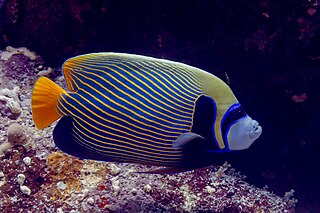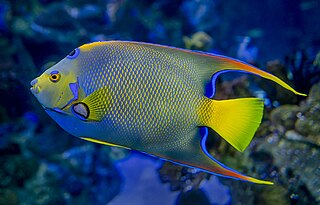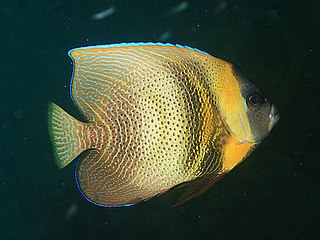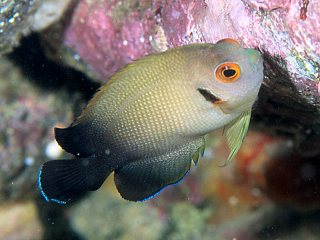
Marine angelfish are perciform fish of the family Pomacanthidae. They are found on shallow reefs in the tropical Atlantic, Indian, and mostly western Pacific Oceans. The family contains seven genera and about 86 species. They should not be confused with the freshwater angelfish, tropical cichlids of the Amazon Basin.

Pomacanthus is a genus of marine angelfish that is usually found around reefs and coral. Some of the notable places one can see these vari-coloured fish includes the Maldives, Sri Lanka, and Sipidan off the southern coast of Sabah, Malaysia. Generally the patterns and colors of these fish undergo a major transformation from juvenile to adult forms. The juveniles may even appear to be a different species.

The cherubfish, also known as the pygmy angelfish, is a species of marine ray-finned fish, a marine angelfish belonging to the family Pomacanthidae. It is found in the western Atlantic Ocean.

The emperor angelfish is a species of marine angelfish. It is a reef-associated fish, native to the Indian and Pacific Oceans, from the Red Sea to Hawaii and the Austral Islands. This species is generally associated with stable populations and faces no major threats of extinction. It is a favorite of photographers, artists, and aquarists because of its unique, brilliant pattern of coloration.

The lemonpeel angelfish, also known as the yellow angelfish, is a species of marine ray-finned fish, a marine angelfish belonging to the family Pomacanthidae. It is found in the Indo-Pacific region.

Pomacanthus paru, also known by its common name the French angelfish, is a slow growing coral reef fish from the tropics with a distinctive and striking appearance. In terms of fish taxonomy, French Angelfish fall under the fish order of Perciformes and under the family Pomacanthidae, which contains other species of marine angelfish. The closest relative of the French Angelfish is the Gray angelfish, or Pomacanthus arcuatus.

The gray angelfish, also written as grey angelfish and known in Jamaica as the pot cover, is a species of marine ray-finned fish belonging to the marine angelfish family, Pomacanthidae. It is found in the Western Atlantic Ocean.

The queen angelfish, also known as the blue angelfish, golden angelfish, or yellow angelfish, is a species of marine angelfish found in the western Atlantic Ocean. It is a benthic warm-water species that lives in coral reefs. It is recognized by its blue and yellow coloration and a distinctive spot or "crown" on its forehead. This crown distinguishes it from the closely related and similar-looking Bermuda blue angelfish, with which it overlaps in range and can interbreed.

The sixbar angelfish, also known as the six banded angelfish, is a species of marine ray-finned fish, a marine angelfish belonging to the family Pomacanthidae. It is found in Indo-Pacific region.

Pomacanthus asfur, the Arabian angelfish, is a species of marine ray-finned fish, a marine angelfish belonging to the family Pomacanthidae. It is found in the Western Indian Ocean.

Genicanthus bellus, the ornate angelfish, bellus angelfish or bellus lyretail angelfish, is a species of marine ray-finned fish, a marine angelfish belonging to the family Pomacanthidae. It is found in the Indo-Pacific region.

Pomacanthus maculosus, the yellowbar angelfish, half-moon angelfish, yellow-marked angelfish, yellowband angelfish or yellow-blotched angelfish, is a species of marine ray-finned fish, a marine angelfish belonging to the family Pomacanthidae. It is found in the western Indian Ocean and, more recently, in the eastern Mediterranean Sea.

Pomacanthus zonipectus, the Cortez angelfish, is a species of marine ray-finned fish, a marine angelfish belonging to the family Pomacanthidae. It is from the Eastern Pacific. It occasionally makes its way into the aquarium trade.

Pomacanthus semicirculatus, also known as the semicircled angelfish, Koran angelfish, blue angelfish, zebra angelfish or half-circled angelfish, is a species of ray-finned fish, a marine angelfish, in the family Pomacanthidae. It is found in the Indo-West Pacific Ocean. It occasionally makes its way into the aquarium trade.

Apolemichthys xanthurus, the Indian yellowtail angelfish, is a species of marine angelfish belonging to the family Pomacanthidae. Other common names include cream angelfish, smoke angelfish, and yellowtail black angelfish. It is found in the Indian Ocean.

Pomacanthus xanthometopon is a marine ray-finned fish, a marine angelfish belonging to the family Pomacanthidae found in shallow parts of the Indo-Pacific. It is commonly known as the blueface angelfish or the yellowface angelfish because of its striking facial colouration.

Centropyge vrolikii, known commonly as the pearlscale angelfish or half black angelfish, is a species of marine ray-finned fish, a marine angelfish belonging to the family Pomacanthidae. It is found in the Indo-Pacific.

The goldtail angelfish, also known as the earspot angelfish, is a species of marine ray-finned fish, a marine angelfish belonging to the family Pomacanthidae. It is found in the western Indian Ocean.

The old woman angelfish is a species of marine ray-finned fish, a marine angelfish belonging to the family Pomacanthidae. It is found in the western Indian Ocean.

Chaetodontoplus mesoleucus, the vermiculated angelfish, is a species of marine ray-finned fish, a marine angelfish belonging to the family Pomacanthidae. It is found in the Indo-West Pacific region.
























